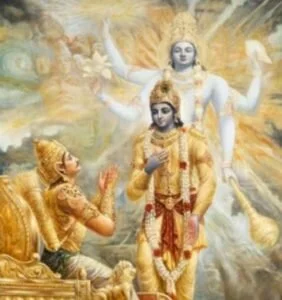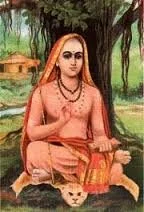Karma yoga (Sanskrit: कर्म योग), or the “discipline of action” is a form of yoga based on the teachings of the Bhagavad Gita, a sacred Sanskrit scripture of Hinduism. Of the four paths to realization, karma yoga is the process of achieving perfection in action. Karma yoga is an intrinsic part of many derivative types of yoga, such as Natya Yoga. Karma yoga is often understood as a yoga of selfless (altruistic) service.
The word karma is derived from the Sanskrit kri, meaning ‘to do’. In its most basic sense karma simply means action, and yoga translates to a union. Thus karma yoga literally translates to the path of union through action. However, in Vedantic philosophy, the word karma means both action and the effects of such action. Karma yoga is described as a way of acting, thinking and willing by which one orients oneself toward realization by acting in accordance with one’s duty (dharma) without consideration of personal self-centered desires, likes or dislikes. One acts without being attached to the fruits of one’s deeds.
Krishna explains that work done without selfish expectations purifies one’s mind and gradually makes an individual fit to see the value of reason. He states that it is not necessary to remain in external solitude or remain actionless, in order to practice a spiritual life, since the state of action or inaction is primarily determined in the mind.
 In the Bhagavad Gita, Krishna says:
In the Bhagavad Gita, Krishna says:
“tasmad asaktah satatam karyam karma samacara asakto hy acaran karma
param apnoti purushah”
Therefore, without being attached to the fruits of activities, one should act as a matter of duty, for by working without attachment one attains the Supreme.
Krishna then goes on to describe how Arjuna should surrender the fruits of his actions (good or bad) to him, Krishna, (as the Supreme Person or avatar) :
Therefore, O Arjuna, surrendering all your works unto Me, with full knowledge of Me, without desires for profit, with no claims to proprietorship, and free from lethargy, fight.
Another important quotations from the Bhagavad Gita which elucidates karma yoga is “योगः कर्मसु कौशलं॥” (yoga is skill in karma.).
The common refrain “सर्वं श्री-कॄष्णार्पणमस्तु॥” is used for the same effect. There is also the following shloka:
कायेन वाचा मनसेंद्रियैर्वा ।
बुद्ध्यात्मना वा प्रकृतिस्वभावात् ।
करोमि यद्यत् सकलं परस्मै ।
नारायणयेति समर्पयामि ॥
which translates to:
Whatever I perform with my body, speech, mind, limbs, intellect or my inner self, either intentionally or unintentionally, I dedicate it to that Supreme Lord Narayana.
As with a number of other philosophies in Hinduism, karma yoga is based on a general understanding of karma and reincarnation (sanskara). It is believed that a man is born with certain tendencies (Sanskaras), both positive and negative, from his previous lives, which push him toward performing certain actions in his present one. This process continues until the individual attains a zero balance (no karma remaining), wherein one achieves liberation.
 Shankaracharya says by practicing karma yoga, one’s mind gets purified.
Shankaracharya says by practicing karma yoga, one’s mind gets purified.
Dharm of each human being is to attain Moksh (realize the true nature of Aatma which is Parmaatma). Moksh frees Aatma from cycle of being born in various life forms (Each life form has to go through a cycle of birth – old age – death). Refer to Shrimad Bhagwad Geeta Chapter 2-40, 18-46 to 18-47, 2-41, 4-27. The true Karm is to implement the process of Yagnya. Refer to Shrimad Bhagwad Geeta Chapter 3-8 to 3-9. Anything other than Yagnyarth Karm is bondage of this world – Sansar Bandhan (Anyatra Lokoyam Karm Bandhanah). The Karm is the one that frees us from Ashubh (that is Sansar Bandhan) – Mokshase Ashubhaat Refer to Shrimad Bhagwad Geeta, Chapter 4-16. The process of Yagnya is Yog Sadhana. Refer to Shrimad Bhagwad Geeta, Chapter 5 and 6. Thus, only Yog Sadhana frees us from Sansar Bandhan and helps us to achieve Moksh. Anything else that we do in the world is due to our inner nature based on Tamo Goon, Rajo Goon and Sattva Goon. Anything other than Yog Sadhana generates Kaam (desires), Krodh (anger), Lobh (greed), Mad (Pride), Moh (attachment) and Matsar (jealousy). The goal of Yog Sadhana Karm is to conquer Kaam (desires), Krodh (anger), Lobh (greed), Mad (Pride), Moh (attachment) and Matsar (jealousy) enemies of human being. Yog also means realization of true nature of Aatma that is Parmaatma.
